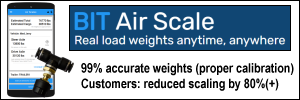Before we list snack foods that can be eaten while traveling, we issue the disclaimer that it can be dangerous to eat while driving.
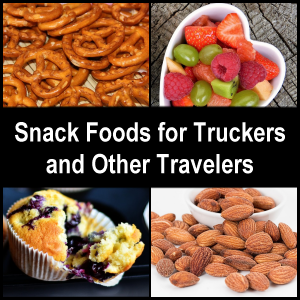 If you are a professional truck driver, you really should keep both hands on the wheel during travel whenever you’re not shifting gears.
If you are a professional truck driver, you really should keep both hands on the wheel during travel whenever you’re not shifting gears.
Some foods require using two hands to eat. (Remember the old “whopper” commercial? “It takes two hands to handle a whopper…”)
You always want to drive safely and not do anything that would cause you to be distracted (like the trucker who pinned fault for his wreck on the chili he was eating).
For the purposes of this page, we will define snacks as foodstuffs eaten between meals.
They may or may not be what you would eat for or with a meal.
Sometimes you just have a craving for something sweet, salty, crunchy or chewy between meals.
That’s where snack foods come in.
We have categorized below a whole range of snack foods and listed each kind of snack food by
- preparation,
- eating,
- clean up, and
- a health note (if relevant).
In cases where a foodstuff needs to be removed from its packaging, this implies using two hands.
Salty Snack Foods
- Popcorn
- Pretzels
- Crackers
- Chips (potato, corn, multi-grain, tortilla)
- Other packaged and bagged salty snacks (Triscuit, Wheat Thins, etc.)
Preparation: If these are commercially prepared, there is no prep time required other than opening the bag. Unpopped corn requires popping — whether in the microwave, in an air popper or by the traditional oil-popping method — and application of optional toppings or flavorings.
Eating: While these foods can be eaten with one hand, small pieces can spill or drop. Oil or salt from these items may cling to fingers. Beware of what you touch while eating, as contaminants can be transferred from surface to surface.
Clean-up: With these foods, this is usually as simple as throwing away (or recycling, if possible) the bag and washing your hands.
Health note: Beware of consuming too much sodium in salty snacks.
Bread-Type Snack Foods
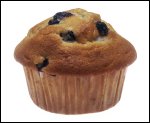 Bread
Bread- Biscuits
- Cakes
- Scones
- Muffins
- Cinnamon rolls
- Monkey bread
- Doughnuts
- Honey buns
Preparation: Some products may be commercially produced or made at home. Depending on your taste, some may be eaten warm or cold. If your desire is a warm snack, you may choose to heat them in the microwave (but beware of any hot spots within). Any kind of topping like butter, jelly, jam or preserves needs to be applied with a utensil.
Eating: Bread type snack foods can crumble and crumbs can scatter. Coatings, toppings or icings can cling to fingers, melt or fall off.
Clean-up: If your snack requires warming, it may first need to be put on a plate. Wash the plate and your hands.
Health note: Some people have gained a good bit of weight by eating a lot of carbohydrates. Be sure to consume a healthy diet to help maintain a good body weight.
Pastry Type Snack Foods
- Pie slices or wedges
- Turnovers
Preparation: Depending on your preference, these items may be eaten cold or warm. If you prefer warm pastries, you may choose to place them on a plate and microwave them for a few seconds. Beware of hot spots.
Eating: Some items may be “dry” enough and small enough to eat by hand; however, may pastry snacks require the use of a utensil. Foodstuffs that require the use of a utensil to eat should never be eaten while driving.
Clean-up: Wash dish, utensil and hands.
Bar-Type Snack Foods
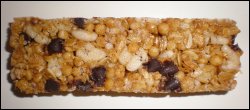 Crisped rice bars
Crisped rice bars- Energy bars
- Granola bars
- Health food bars
- Protein bars
Preparation: These items are simple to prepare, usually requiring only the opening of a package. Beware of needing to use two hands to open any package.
Eating: Depending on the bar, coatings or toppings can cling to fingers. Bars may crumble.
Clean-up: Throw away the wrapper and wash your hands.
Dairy Snack Foods (All of these are meant to be eaten cold)
 Cheese: cubes
Cheese: cubes- Cheese: slab
- Cheese: slice
- Cheese: stick
- Cottage cheese
- Yogurt
- Ice cream: bars, cones, cups
- Pudding
Preparation: Slab cheese has to be cut; sliced cheese has to be separated from the stack or packaging; stick cheese has to be unwrapped. These maneuvers require two hands. Foodstuffs that come with a lid on top must be opened with two hands. Prepare appropriate utensils and dishes.
Eating: Cottage cheese and yogurt have to be dipped or spooned out of a container, the lid of which has been removed. Ice cream bars and cones should not be laid down once opened. Cups of ice cream and pudding require two hands for handling.
Clean-up: Clean up any utensils or dishes you have used, along with your hands.
Seeds as Snack Foods
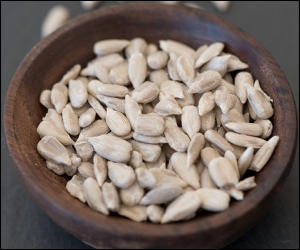 Flaxseed
Flaxseed- Pumpkin kernels
- Pumpkin seeds (in shell)
- Sunflower kernels
- Sunflower seeds (in shell)
Preparation: Small kernels are easier to handle if they are first put in a small cup. Shelled seeds must be broken out of shells individually before eating.
Eating: Seeds may be transferred from the cup into one’s mouth. If the cup contains more seeds than can be eaten in a single sitting, it can be capped or covered until the next snack. Some people prefer to crack shelled seeds in their mouths and then spit out the shells. Be careful not to swallow shell pieces. Set up a depository for the empty shells as they are emptied.
Clean-up: Throw out empty packaging and any discarded shells.
Nuts as Snack Foods
- Almonds
- Brazil nuts
- Cashews
- Hazelnuts
- Peanuts
- Pecans
- Pistachios
- Walnuts
- Nut butters
Preparation: Nuts in shells must first be broken out of their shells, requiring two hands. Nut meat may be easier to handle if put in a small cup. Nut butters must be eaten or spread with a utensil using two hands.
Eating: Nuts may be transferred from the cup into one’s mouth. If the cup contains more nuts than can be eaten in a single sitting, it can be capped or covered until the next snack.
Clean-up: Wash utensils (nut crackers and knives), dishes and your hands.
Sweet Snack Foods
- Candy bars
- Candies, coated (like M&Ms)
- Candies, hard (like Jolly Ranchers)
- Candies, mints (like Life Savers)
- Candies, soft (like Tootsie Rolls)
- Gelatins
- Goo-goo clusters
- Lollipops
Preparation: Opening most candies and sweet snacks requires two hands. Gelatins must be transferred to one’s mouth from the container via fork or spoon.
Eating: Some of these items may be in individual serving sizes (such as one mint candy per package). With others (such as lollipops), the sweet snack can be covered and worked on again at another time. Be sure to keep cool anything that needs to be kept cool (such as gelatin desserts).
Clean-up: Throw away candy wrappers. Wash dishes, utensils and your hands.
Fruit, Berries, Citrus, Melons and Dried Fruit Snack Foods
Fruit:
- Applies: As is or cut into quarters; remove core.
- Bananas: Peel
- Grapes: Pull off vine
- Peaches: As is or cut into slices; remove pit.
- Pears: As is or cut into slices; remove core.
- Pineapple: Peel and cut into slices or chunks; remove core.
- Plums: As is; remove pit.
Berries:
- Blackberries
- Blueberries
- Cherries (remove pits)
- Raspberries
- Strawberries (remove stem and core)
Citrus Fruits: Peel and segment
- Grapefruit
- Oranges
- Nectarines
- Tangerines
Melons: 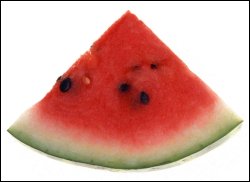 Cut off rind, cut into pieces, remove seeds (if seeded)
Cut off rind, cut into pieces, remove seeds (if seeded)
- Cantaloupe
- Honeydew
- Watermelon
Dried fruit: Watch out for preservatives and coatings on these
- Dried apricots
- Dried bananas
- Dried berries
- Dried dates
- Dried pineapple
- Prunes
- Raisins
Preparation: Many of these fruit snacks are eaten raw. Some may be quite drippy (like a nice juicy peach). Fruits combined into a salad may also be quite drippy. You’ll want to keep a supply of napkins on hand. In any case where a fruit is canned, eating will naturally require using 2 hands: 1 to hold the can or bowl, 1 to wield the fork or spoon. Melons require preparation. Some melons are so large that they require eating in separate sittings; they may also require being stored in a bowl or being kept cool.
Eating: Beware of having to use two hands for the preparation or eating of any of these items. Fruits contain natural sugars which can make your hands and the things that they come in contact with sticky.
Clean-up: Discard peels, cores, stems and pits — and, where appropriate, the seeds. Wash utensils, dishes and your hands.
Vegetable Snack Foods
Some stores carry trays of these items already prepared — for a price.
With a little advanced planning, you can prepare them yourself and save money.
Some people like to dip their veggies into some kind of dressing or sauce prior to eating them.
 Bean sprouts: Clean
Bean sprouts: Clean- Broccoli: Clean, remove fibrous stems near ends, cut into pieces
- Carrots: Clean, peel, remove ends, cut into pieces (unless sold as baby carrots)
- Cauliflower: Clean, remove core, cut into pieces
- Celery: Separate, remove ends, clean, cut into pieces
- Cucumber: Clean, cut into pieces with or without skin
- Lettuce: Clean, separate leaves
- Onions (French fried): Open package
- Peppers: Clean, quarter, remove core and seeds
- Soybeans: Clean
- Soynuts (made from soybeans)
- Spinach leaves (baby): Clean
- Squash: Clean, remove ends, slice
- Tomatoes, cherry or grape: Clean
- Zucchini: Clean, remove ends, slice
Preparation: Some vegetable snacks may be refrigerated while others may be stored at room temperature. Prepare them as listed above into bite-sized pieces.
Some people like to prepare vegetables with tools like these as listed on Amazon.com, with which we have an affiliate relationship.
Veggetti Pro:
Mandoline slicer
Eating: Some items may be eaten a slice, item or small clump at a time. If they are first dipped before eaten, be careful that the container of dipping sauce will not fall over or spill.
Clean-up: Wash any utensils or dishes — and your hands.
Health note: Take proper precautions when using instruments and/or tools with sharp blades.
Meat Snack Foods
- Jerky
- Lunch meat
Preparation: Jerky can be eaten straight from the package. Lunch meat will need to be separated from the package and, if eaten by itself, rolled up.
If you’re really into eating jerky, you may find that making it yourself (or having your home support team do so) will save you heaps of money. To make jerky at home or in-truck, a tool like this comes in very handy:
Eating: Meat items may be eaten with a single hand, but beware of potential contamination.
Clean-up: Wash dishes and your hands.
Dry cereals
- Bran flakes
- Cheerios
- Kix
Preparation: Like seeds and nuts above, these may best be handled by placing them in a small cup.
Eating: Items can be transferred to one’s mouth from the cup. Unfinished items can be left in the cup and capped, covered and finished later — as long as they are dry. Beware that small items can crumble or fall out of the cup on the way to your mouth.
Clean-up: Wash all dishes and your hands.
Combination Snack Foods
- Chex mix
- Granola
- Trail mix
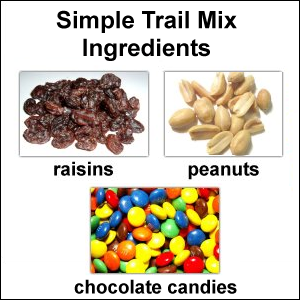
Preparation: You can make your own mixes at home and save money. For example in the image above, a simple trail mix can be made by combining raisins, dry roasted peanuts and chocolate candies. If obtained commercially, prepare combo snacks by opening the package (which will probably require two hands). These items may best be handled by placing them in a small cup.
Eating: Small items can crumble or fall while being transferred to one’s mouth.
Clean-up: Wash dishes and your hands.
Snack Food Dips
- French onion dip
- Ranch dressing
Preparation: These dips need to be kept cold (in a refrigerator or on ice in an ice chest) to keep from spoiling. You can make your own French onion dip by mixing a dry pack of onion soup mix in sour cream. There are also recipes for making your own ranch salad dressing.
Eating: When you dip foodstuffs in these dips, beware that some can fall off the food on the way to your mouth. (Some of us prefer lightly dipping foods while others heavily “dredge” their foods through the dips. Note: Vicki lightly dips her veggies; Mike dredges his veggies.)
Clean-up: Cover any unused portion after eating and keep cold. Wash any and all empty containers and your hands.
Health note: Some French onion dips — and some dried soup mixes from which some homemade dips are made — contain “flavor enhancers” which are toxic. Watch out for monosodium glutamate and disodium inosinate.
Drinks as Snack Foods
We don’t recommend using these as a snack food.
- Energy drinks
- Energy shots
- Fruit juice
- Fruit punch
- Hot chocolate
- Sports drinks
- Tea
Preparation: Opening single-serve containers requires two hands. Fruit juice or punch from larger containers may need to be transferred into a non-spill type cup. Hot chocolate and hot tea need to be prepared with hot water, a cup and spoon. Beware of spills.
Eating (or in this case drinking): Make sure that you have a secure place to put the container between sips. Spills can happen in numerous ways.
Clean-up: Throw away disposable containers. Wash non-disposable containers. Wash your hands.
Health note: Some sports drinks and energy drinks contain ingredients that may not be healthy. Among them are a high amount of caffeine.
![]() Money saving tip: You can save money by preparing many of these snack foods ahead of time yourself.
Money saving tip: You can save money by preparing many of these snack foods ahead of time yourself.
For example, contrast the price of commercially prepared vegetable trays with a few pieces of unprepared vegetables from a whole stalk of celery, a whole bag of carrots, etc.
You can also save money by preparing certain salty or sweet snacks yourself.
(We wish there was an easy and inexpensive way to make our own consistently shaped and salted pretzels. Perhaps one of our readers will suggest one.)
Beware that snacks are not meant to substitute for good, wholesome foods eaten during meals.
You can fill up on snacks and have no room left for the good stuff.
Beware of “mindless eating” while you’re focused on other things.
Depending on the snack food selected and if you’re not careful, you can easily consume hundreds of calories in a single sitting.
Some foods are more calorie dense than others, so pay attention to your choices.
The more natural your snack choices, the better off you’ll be health-wise.
Grazing on less calorie dense foods and incorporating appropriate exercise can help you lose weight or maintain a healthy weight.
Many a truck stop has a display of fresh fruit — typically bananas and apples.
Generally, the per-piece cost of these fruits is high when compared to their per-pound cost in a regular grocery store.
However, if this is the only way you can obtain fresh fruit, it is better to buy and eat it from a truck stop than to fill up with sugar-laden, calorie-loaded options.
Depending on where you pick up or deliver your loads, there may be a grocery store nearby to which you can bobtail or walk while your trailer is in the dock.
Ask if you can drop your trailer long enough to do a little shopping and come back.
Consider your options.
You can make your own fruit salad from fresh, frozen or canned ingredients.
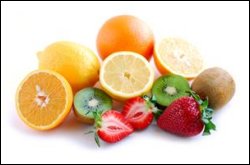 For example, you can add in
For example, you can add in
- fresh or canned pineapple,
- fresh or canned peaches,
- canned mandarin oranges or fresh orange segments,
- some fresh grapes, and
- slice in a fresh banana.
Yum!
Use whatever fresh, frozen or canned fruit combination you desire.
Finally, eat your foodstuffs in a timely manner.
For example, fresh bananas are good for a very limited time.
Past that time frame, they may be used for banana bread or other baked products.
Past even that time frame, they will need to be discarded.
Plan your snacks well and you’ll be happy.
Return from Snack Foods for Professional Truck Drivers and Other Travelers to our Food and Recipes page or our Truck Drivers Money Saving Tips home page.














